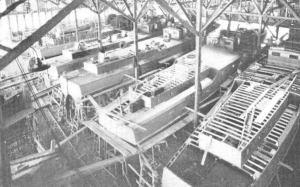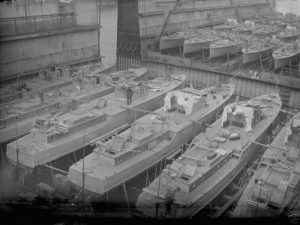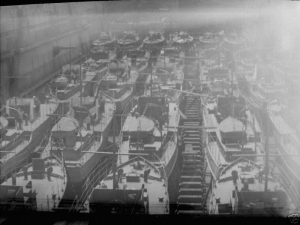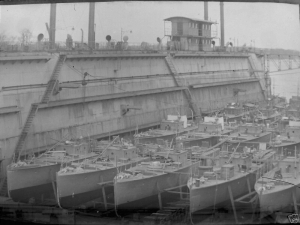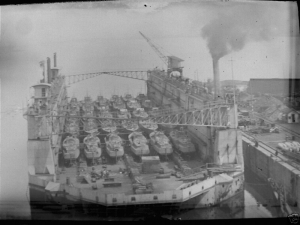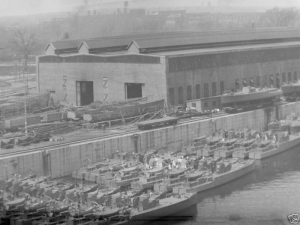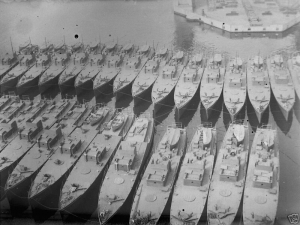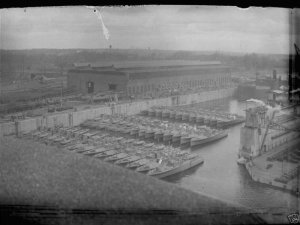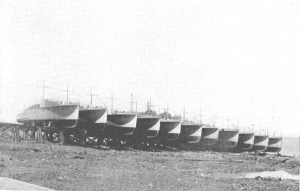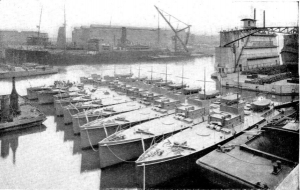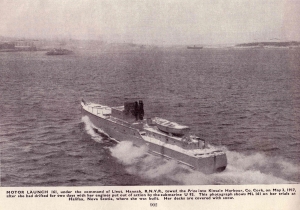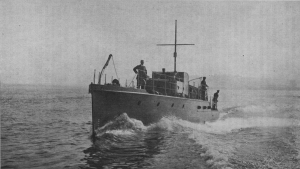Design and Construction
There are few good sources of detailed information regarding the design evolution and construction history of the Motor Launch. Those that do exist fall into one of two categories: those written shortly after the fact, in the late Teens or early Twenties, and more recent research being conducted as part of a late 20th century interest in the War as a whole and, more pertinently, the Electric Launch Company (Elco) and its early history.
Within the former category two books provide the bulk of the information (and various other books add small details—see Written Accounts for more information). The first, a prologue to The Motor Launch Patrol provided by Henry R. Sutphen, General Manager of the Electric Launch Company (Elco) gives what we might assume to be an authoritative overview of the genesis of the construction efforts by Elco—straight from the horse's mouth as it were. The second, an introductory chapter to The Cinderellas of the Fleet by William Washburn Nutting serves as the preliminary groundlaying for the primary topic of that book—the US Navy Sub-Chasers which were the logical design evolution of the Motor Launch. A drawback to both books, from a research perspective, is a bit of intentional "intrigue" regarding the context within which the ML's were conceived and, in the case of Nutting's book, the fact that the history is essentially advertising—given that The Cinderellas of the Fleet was published by The Standard Motor Construction Company, makers of the ML powerplants. Thus, the information tends to be quite rosy and less-than-detailed in the particulars.
There are few good sources of detailed information regarding the design evolution and construction history of the Motor Launch. Those that do exist fall into one of two categories: those written shortly after the fact, in the late Teens or early Twenties, and more recent research being conducted as part of a late 20th century interest in the War as a whole and, more pertinently, the Electric Launch Company (Elco) and its early history.
Within the former category two books provide the bulk of the information (and various other books add small details—see Written Accounts for more information). The first, a prologue to The Motor Launch Patrol provided by Henry R. Sutphen, General Manager of the Electric Launch Company (Elco) gives what we might assume to be an authoritative overview of the genesis of the construction efforts by Elco—straight from the horse's mouth as it were. The second, an introductory chapter to The Cinderellas of the Fleet by William Washburn Nutting serves as the preliminary groundlaying for the primary topic of that book—the US Navy Sub-Chasers which were the logical design evolution of the Motor Launch. A drawback to both books, from a research perspective, is a bit of intentional "intrigue" regarding the context within which the ML's were conceived and, in the case of Nutting's book, the fact that the history is essentially advertising—given that The Cinderellas of the Fleet was published by The Standard Motor Construction Company, makers of the ML powerplants. Thus, the information tends to be quite rosy and less-than-detailed in the particulars.
In the latter category I am indebted to the work of Bill Swanson, Elco historian and author of what promises to be a definitive work on the subject of the Motor Launch. Drawing upon personal communications between Mr. Swanson and myself, and information from his 1985 article Elco: A History published in Nautical Quarterly, I believe some gaps have been filled and we can read some of the earlier writings by Sutphen and Nutting in a slightly different, more informative light. For instance, Mr. Swanson indicates (personal communication) that it is entirely likely that the prologue provided by Henry Sutphen in The Motor Launch Patrol was, in fact, ghost-written by William Nutting.
Conception
It is not within the scope of this site to provide a history of Elco beyond its involvement with the Motor Launch. Suffice it to say that the Electric Launch Company (Elco) had been purchased in 1899 by Isaac Leopold Rice and merged with the Holland Torpedo Boat Company. These companies were further merged with other Rice holdings to form the Electric Boat Company (which would become General Dynamics in 1952). Elco was managed for Rice by Henry Sutphen. Sutphen, in turn, hired Irwin Chase when he graduated from the University of Michigan in 1906 - replacing Alfred Luders (designer of the beautiful Luders Yawls used for many years as the Naval Academy sail training boats). With this the stage was set: electric motor experience, submarine design and construction experience (including the licensing of Holland designs to Vickers Sons & Maxim of England), mass-production experience (building fifty electric launches for the 1892 World's Fair), and fast powerboat experience (Chase was a speedboat devotee with a burgeoning track record of successful designs by 1914). Perhaps just as important, the business ties with the Admiralty in England, by way of the Vickers relationship, was already in place. As Swanson relates in Elco: A History:
Conception
It is not within the scope of this site to provide a history of Elco beyond its involvement with the Motor Launch. Suffice it to say that the Electric Launch Company (Elco) had been purchased in 1899 by Isaac Leopold Rice and merged with the Holland Torpedo Boat Company. These companies were further merged with other Rice holdings to form the Electric Boat Company (which would become General Dynamics in 1952). Elco was managed for Rice by Henry Sutphen. Sutphen, in turn, hired Irwin Chase when he graduated from the University of Michigan in 1906 - replacing Alfred Luders (designer of the beautiful Luders Yawls used for many years as the Naval Academy sail training boats). With this the stage was set: electric motor experience, submarine design and construction experience (including the licensing of Holland designs to Vickers Sons & Maxim of England), mass-production experience (building fifty electric launches for the 1892 World's Fair), and fast powerboat experience (Chase was a speedboat devotee with a burgeoning track record of successful designs by 1914). Perhaps just as important, the business ties with the Admiralty in England, by way of the Vickers relationship, was already in place. As Swanson relates in Elco: A History:
The submarine-building business was not especially lucrative prior to 1915. Rice (Isaac Leopold Rice) made do by selling licenses for the Holland submarine to any foreign firm that had the cash. One such customer was Vickers Sons & Maxim of England, at that time vying with Krupp as the world's largest defense contractor. Vickers' famous managing director, Sir Trevor Dawson, bought a submarine license from Rice in 1900 and began building subs for the Admiralty at the Vickers yard in Barrow-in-Furness. Vickers' relationship with Rice and Electric Boat continued through World War 1, and Vickers was even a major holder of Electric Boat Company stock. This relationship led to the construction of the sub-chasing motor launches. "It was in February 1915 that we had our initial negotiations with the British naval authorities," Sutphen later wrote. "A well-known English shipbuilder and ordnance expert was in this country, presumably on secret business for the Admiralty, and I met him one afternoon at his hotel." The Admiralty representative was Sir Trevor. Sutphen and Dawson discussed the German submarine menace, and Sutphen recommended that the Admiralty purchase "a number of small, speedy gasoline motorboats for use in attacking submarines. My idea was to have a mosquito fleet big enough thoroughly to patrol the coastal waters of Great Britain." Whether this idea originated with Sutphen is not clear. Dawson had been dispatched to America by Winston Churchill, then First Lord of the Admiralty. Churchill, in turn, seems to have been prompted by the First Sea Lord, Admiral Sir John "Jacky" Fisher, the man credited with dragging the mighty British Navy--kicking and screaming most of the way--into the 20th Century. In a handwritten note recently unearthed in Admiralty files and dated February 3, 1915, Fisher wrote to "Dear Winston":
"I earnestly press you to hire Sir Trevor Dawson at once to go to America as our Buyer ... we want a 'pusher' like Dawson ... send him and then arrange afterward the necessary authority (to negotiate)...'Munitions are the breath of war!' What use millions of Russians without rifles or our monitors without cordite. This is a Big War! So send Sir Trevor Dawson by the [steamship] Adriatic sailing tomorrow from Liverpool to New York.
It appears that Dawson's mission was to purchase rifles from a source in Brazil, as well as nitroglycerine. There is no mention of subchasers or of Elco, so it is conceivable that Sutphen did originate the antisubmarine "mosquito fleet" idea, and that he obtained an interview with Dawson to propose it [JLC - some would argue against this]. How Sutphen knew that Dawson was in New York has not yet been explained, nor is it clear why so important a man as Sir Trevor was necessary to negotiate the purchase of Brazilian-made rifles. It is not even clear why Fisher and Churchill were interested in rifles in the first place; while neither man could ever be accused of minding his own business rifles were a long way from Fisher and Churchill's designated responsibilities. Their interest in nitroglycerine is more understandable: it was the principal ingredient in making guncotton, at that time the major propellent in cannon shells they needed for their ships.
Elco: A History
It does seem clear that the visiting dignataries knew exactly what they were looking for and where to go about getting it. With his introduction in The Cinderellas of the Fleet Nutting relates that the delegation of engineers from England proceeded immediately to the Standard Motor Construction Company factories on the very evening of their debarkation in New York. The lights were left on late just for this visit. Clearly it had been decided that this was the best choice for providing the engines that would be required by the soon-to-be-devised Motor Launch.
And with Sir Trevor's existing ties to Electric Boat and Rice the involvement of Elco in the design and construction of the boats particularly given their reputation for being able to quickly produce a large number of standardized boats seemed the logical choice for the coming endeavor—and a possible source for controversy after the war when questions might arise as to exactly who was profiting by what appears to have been a done deal before it was ever formally suggested.
And with Sir Trevor's existing ties to Electric Boat and Rice the involvement of Elco in the design and construction of the boats particularly given their reputation for being able to quickly produce a large number of standardized boats seemed the logical choice for the coming endeavor—and a possible source for controversy after the war when questions might arise as to exactly who was profiting by what appears to have been a done deal before it was ever formally suggested.
Sutphen recounts some of this in the prologue of The Motor Launch Patrol. He notes that he initially met with a "representative" of the Admiralty in February of 1915 (the disclosure of names wouldn't have been discreet in 1919). At this time he tells us he recommended a "mosquito" fleet of small fast motor launches well-suited to submarine chasing and patrol work in general. These boats would meet the specifications and requirements outlined by the Admiralty. They would be about 80' in length, have a top speed of 19 knots, and would carry some sort of quick-firing gun. On April 9, 1915 a contract was signed for delivery of 50 such craft (though these first 50 were 75' in length). Swanson provides more detail about the closing of the deal.
Using code sent through the Office of Naval Intelligence, Dawson cabled the details of Sutphen's proposal to the Admiralty, along with details of the Brazilian arms deal. The cable traffic was couched in the formal language of the era, and has the tone of Hornblower's correspondence.
"The Director of the Intelligence Division presents his compliments to the Under Secretary of State for Foreign Affairs, and begs to request that the attached telegram may be sent, if no objection is seen, to Sir Trevor Dawson, c/o the British Ambassador, Washington. Your telegram of [March] 21st Admiralty will take 50 torpedo launches provided that the speed of 19 knots can be guaranteed ... the boats must be thoroughly sea-worthy and strong enough to carry a 3 pounder gun forward.. Torpedo tubes are not required.. Do not forget that all purchases must be made through Messrs. Morgan [J. Pierpont Morgan's bank] with whom you should keep in close and harmonious relation. Despatch is necessary.
The contract for these 50 motor launches was signed on April 9, 1915, and by the first of May Elco had the first boat's frames erected. This boat would be used to create standardized patterns for the remainder of the order. The speed with which Elco prepared the drawings and patterns strongly suggests that Chase and Sutphen had been working on this project well in advance of the authorizing order, and possibly as far back as the initial negotiations in February.
Elco: A History
Sutphen notes that on the first of May, 1915 the master pattern boat was already in frame at the Bayonne plant. It was also on the May 1st that the Lusitania sailed on her last voyage and, one week later, was torpedoed and sunk. This prompted the Admiralty to revise their order—adding an addition 500 launches (these to be 80' in length). With this revision of the order Sutphen commited to delivering one boat a day for any length of time the Admiralty cared to specify. Ultimately, Elco was contracted to build 550 motor launches for delivery by November 16, 1916 (for a total of $22 million dollars according to Bill Swanson—which, given an exchange rate of about 0.21 British Pounds to the US Dollar in 1915, came to about £8400 per boat).
Design
The task of designing the new boat fell to Irwin Chase, Elco's chief designer. He had quite a task ahead of him. The requirements presented by the Admiralty were, when taken as a whole and given the technology of the time, daunting to say the least. The minimum speed, fully loaded, was to be 19 knots. The specified cruising radius called for a fuel capacity of 2,000 gallons—a weight of 12,000 pounds just for fuel! A deadweight of 20,000 pounds, the equivalent of the weight of the guns, ammunition, water and supplies, etc. must also be accomodated. And that in addition to the weight of the boat and its power plant. Next came the consideration of seaworthiness. The boat must be able to maintain station in any weather. Finally, due to the nature of the standardized construction and contracted delivery times, the details of the construction had to be kept simple. No double planking of the hull for strength, etc. And finally, to facilitate delivery, the boats had to fit four at a time on the deck of a steamer for transport across the Atlantic.
Nutting states:
The task of designing the new boat fell to Irwin Chase, Elco's chief designer. He had quite a task ahead of him. The requirements presented by the Admiralty were, when taken as a whole and given the technology of the time, daunting to say the least. The minimum speed, fully loaded, was to be 19 knots. The specified cruising radius called for a fuel capacity of 2,000 gallons—a weight of 12,000 pounds just for fuel! A deadweight of 20,000 pounds, the equivalent of the weight of the guns, ammunition, water and supplies, etc. must also be accomodated. And that in addition to the weight of the boat and its power plant. Next came the consideration of seaworthiness. The boat must be able to maintain station in any weather. Finally, due to the nature of the standardized construction and contracted delivery times, the details of the construction had to be kept simple. No double planking of the hull for strength, etc. And finally, to facilitate delivery, the boats had to fit four at a time on the deck of a steamer for transport across the Atlantic.
Nutting states:
And so it was with an absolutely clean slate that Mr. Chase went to work. Several sets of lines were drawn up as quickly as possible from which models were made and in order to determine beyond a doubt which of these would best meet the requirements, a flying trip was made to the University of Michigan where they were towed in the experimental tank. [J. Charles - Chase being an alumnus of the University] There had to be a compromise between speed and seaworthiness and after elaborate tests in the basin, a model was decided upon which had fairly fine lines forward and a rather flat after underbody or run, but still with considerable underwater body or deadrise as the depth of the boat from the turn of the bulge to the keel is called.
One of the models was more symmetrical in shape with the V-sections carried clear to the stern, but while this might have proved a trifle easier especially when running before a sea, it was found impossible to attain a speed of 19 knots with reasonalbe power on a length of 75 feet. The latter model, the so-called more seaworthy model of the two under discussion, was found more easily driven up to a speed of 15 knots but beyond this the advantage was all with the boat with the flat run, especially when trimmed by the stern.
From the start the designer and the British Commission were determined to employ medium speed motors, for the boats were to be used day in and day out and they could not afford to risk a high speed machine in a decidedly heavy duty outfit. Twin Standard air-starting and reversing motors, rated at 220 horsepower each seemed the logical power plant.
One of the models was more symmetrical in shape with the V-sections carried clear to the stern, but while this might have proved a trifle easier especially when running before a sea, it was found impossible to attain a speed of 19 knots with reasonalbe power on a length of 75 feet. The latter model, the so-called more seaworthy model of the two under discussion, was found more easily driven up to a speed of 15 knots but beyond this the advantage was all with the boat with the flat run, especially when trimmed by the stern.
From the start the designer and the British Commission were determined to employ medium speed motors, for the boats were to be used day in and day out and they could not afford to risk a high speed machine in a decidedly heavy duty outfit. Twin Standard air-starting and reversing motors, rated at 220 horsepower each seemed the logical power plant.
The Cinderellas of the Fleet
Construction
Due to the requirements of the Wilson administration that a strict neutrality of the United States be maintained an initial subterfuge was employed in delivering the initial batch of 50 ML's for shipment overseas. Contrary to what Sutphen (or Nutting) notes in his Prologue to The Motor Launch Patrol the first 50 boats were indeed built at the Bayonne, New Jersey Elco yard. To avoid possible controversy (or to remedy a rising controversy) in delivering these first 50 boats, a solution was arrived at whereby the topsides of each boat were painted white (as opposed to grey, white being considered a "civilian" yacht colour). These first 50 boats were sailed on their own bottoms to Halifax for delivery to the British (personal communication with Bill Swanson).
Thereafter it was determined that the boats would be assembled in Canada. Two yards, one in Montreal and one in Quebec, were located and leased. All components of the boats were crafted in the U.S. at the Elco Bayonne plant or at the factories of sub-contractors and shipped to the yards in Canada for final assembly. Sutphen notes that the usual Elco supplier of bronze component assemblies such as rudders and quadrants was unable to deliver the required level of mass-production. Instead, the Tiffany studios in New York, producers of bronze sculpture and lighting fixtures, was contracted and successfully delivered everything demanded of them.
Armaments were typically installed by the Royal Navy after shipment to England as part of the general fitting out process when the boats were being commissioned.
Due to the requirements of the Wilson administration that a strict neutrality of the United States be maintained an initial subterfuge was employed in delivering the initial batch of 50 ML's for shipment overseas. Contrary to what Sutphen (or Nutting) notes in his Prologue to The Motor Launch Patrol the first 50 boats were indeed built at the Bayonne, New Jersey Elco yard. To avoid possible controversy (or to remedy a rising controversy) in delivering these first 50 boats, a solution was arrived at whereby the topsides of each boat were painted white (as opposed to grey, white being considered a "civilian" yacht colour). These first 50 boats were sailed on their own bottoms to Halifax for delivery to the British (personal communication with Bill Swanson).
Thereafter it was determined that the boats would be assembled in Canada. Two yards, one in Montreal and one in Quebec, were located and leased. All components of the boats were crafted in the U.S. at the Elco Bayonne plant or at the factories of sub-contractors and shipped to the yards in Canada for final assembly. Sutphen notes that the usual Elco supplier of bronze component assemblies such as rudders and quadrants was unable to deliver the required level of mass-production. Instead, the Tiffany studios in New York, producers of bronze sculpture and lighting fixtures, was contracted and successfully delivered everything demanded of them.
Armaments were typically installed by the Royal Navy after shipment to England as part of the general fitting out process when the boats were being commissioned.
Charles Lamont was the chief boat constructor. The two 220 horsepower gasoline engines and single auxilliary engine were supplied by Eugene Riotte of the Standard Motor Construction Company. Sutphen maintained that the key to the success of the entire enterprise was strict standardization of parts and assembly. Indeed, the two Canadian yards, Canadian Vickers Limited of Montreal and Davie Shipbuilding and Repairing Company Limited of Quebec, employed a force of carpenters with little boat-building experience (or even the ability to speak English). So it was essential that things be standardized to a high degree. An unusual requirement for wooden boat building to say the least.
Sutphen says that 130 transport ships were required to deliver the 550 motor launches to England—four launches per ship. Not a single ML was lost to mishap during the Atlantic crossing and all 550 were delivered in 488 days! Chatterton notes in The Auxilliary Patrol that ML's 1, 2, and 3, part of the first batch of 50 ML's, were commissioned at Portsmouth by October 14, 1915. An additional 30 or so ML's were delivered to the Royal Navy later in 1917 making the total 581.
Undoubtedly, one of the challenges the Royal Navy faced in acquiring so many Motor Launches so quickly was providing crew! The two officers typically assigned to each ML were men of the RNVR. The balance (eight men) would have included motor mechanics, deckhands, signalmen, cooks, etc. - some of whom would also have been RNVR (Chief Motor Mechanics for instance) while others would have been RNR. Given the relatively new experience with petrol engines within the navy, the mechanical positions may have been the most challenging roles to fill. This add from the 17 February, 1916 issue of The Motor Ship and Motor Boat is indicative of the need:
Sutphen says that 130 transport ships were required to deliver the 550 motor launches to England—four launches per ship. Not a single ML was lost to mishap during the Atlantic crossing and all 550 were delivered in 488 days! Chatterton notes in The Auxilliary Patrol that ML's 1, 2, and 3, part of the first batch of 50 ML's, were commissioned at Portsmouth by October 14, 1915. An additional 30 or so ML's were delivered to the Royal Navy later in 1917 making the total 581.
Undoubtedly, one of the challenges the Royal Navy faced in acquiring so many Motor Launches so quickly was providing crew! The two officers typically assigned to each ML were men of the RNVR. The balance (eight men) would have included motor mechanics, deckhands, signalmen, cooks, etc. - some of whom would also have been RNVR (Chief Motor Mechanics for instance) while others would have been RNR. Given the relatively new experience with petrol engines within the navy, the mechanical positions may have been the most challenging roles to fill. This add from the 17 February, 1916 issue of The Motor Ship and Motor Boat is indicative of the need:
MOTOR-BOAT MEN AND MECHANICS REQUIRED.
In addition to the demand for skilled mechanics and good motor-boat drivers with knowledge of engines (particularly hot-bulb engines), there is at the moment a special need for a number of men who have been accustomed to marine motors, preferably of large size and of the paraffin type, for service in a special branch of the Forces. These men must have had mechanical experience, and good pay will be given.
Letters should be addressed to the Editor, The Motor Ship, And Motor Boat, 7-15, Rosebery Avenue, London, E.C., and it is important that full details of mechanical and other experience should be given. Navigation knowledge is not required.
In addition to the demand for skilled mechanics and good motor-boat drivers with knowledge of engines (particularly hot-bulb engines), there is at the moment a special need for a number of men who have been accustomed to marine motors, preferably of large size and of the paraffin type, for service in a special branch of the Forces. These men must have had mechanical experience, and good pay will be given.
Letters should be addressed to the Editor, The Motor Ship, And Motor Boat, 7-15, Rosebery Avenue, London, E.C., and it is important that full details of mechanical and other experience should be given. Navigation knowledge is not required.
The Motor Ship and Motor Boat
According to Elco records, upwards of 200 additional motor launches were built for delivery to other countries including France and Italy and perhaps even Russia. We know that the French navy had at least four ML's - these are noted by C. Sanford Terry as having participated in the actions at Zeebrugge and Ostend. However, his mention of the French ML's references numbers (1, 2, 33, and 34) don't correspond to the ML (or Vedette) listing for the French Navy in Jane's Fighting Ships 1919. It may be that the French boats participating in the raids were not the Elco-built Vedettes. Or perhaps their numbering was changed for some reason. Either way, given the information available, we can surmise that the French navy had at least 40 Canadian-built ML's by war's end. Janes Fighting Ships 1919 also notes that the Russian Navy had a fleet of small motor launches of various designs and sizes—including some designed (and maybe even built) by American firms. No more particulars are given. Nutting notes in The Cinderellas of the Fleet that Elco ultimately produced 701 ML's for export to US allies (he actually states 720 but that figure also includes the Sub-Chasers that Elco itself actually produced).
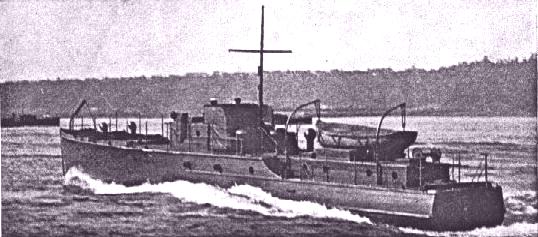
Over seven hundred of these 80ft. subchasers, known as ML's, |
Though there were really only two revisions or "series" of Motor Launches produced by Elco between 1915 and 1919 a third type is mentioned in Jane's Fighting Ships 1919. Given that there was an additional order for about 30 ML's the confusion is understandable. However, Bill Swanson indicates that Jane's was actually incorrect in reporting on the third series and that, design-wise, there were really only the two. The numbering of the ML's taking part in the attacks on Zeebrugge and Ostend in the spring and summer of 1918 it seems that the third batch of ML's to the Royal Navy must have been delivered no later than very early spring 1918. Indeed, Maxwell notes:
Owing to a slight eleventh-hour alteration in the plans of the M.L.s, it became necessary to find someone almost at the last moment to take on the none too enviable task of marking the Bell bouy, which is well inshore from the Stroom Bank and not far from the harbour mouth. Lieut. R. Proctor undertook to do this in M.L. 556, in spite of the fact that his boat was so newly commissioned as to be incomplete in many important details, and possessed a crew who were as new to M.L. life as the boat itself. However, by very strenuous hustling, Lieut. Proctor managed to get some semblance of order out of chaos, and to instruct his crew (first having to learn it himself) in the art of dropping smoke-floats.
The Motor Launch Patrol
Even so, minor design alterations—even those done as part of the commissioning based upon what the ML crews were learning and relating back to the Royal Navy—were clearly taking place. We have but to look at the photographic evidence to see clear distinctions between the early ML's delivered to the Royal Navy and those (of higher number) active towards the end of the war. No difference in basic form perhaps, but perhaps better accomodation made to service conditions not anticipated by the designer.
